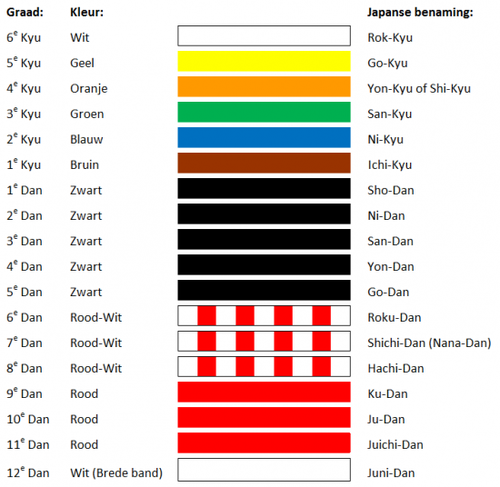The Judo Ranking System
A judoka’s belt is not just practical—it represents their growth, skill, and dedication. Judo uses a structured grading system that guides practitioners from beginner to master.
Kyu and Dan Grades
There are 16 recognised grades in judo before reaching the top. These are divided into:
Kyu grades – for beginners
Dan grades – for advanced judoka
In the kyu system, ranks count downward:
6th kyu (white belt)
5th kyu (yellow)
4th kyu (orange)
3rd kyu (green)
2nd kyu (blue)
1st kyu (brown)
After earning the 1st kyu, judoka become eligible for dan grades, beginning with the black belt (1st dan). From there, ranks count upward, all the way to the 10th dan.
Did You Know?
According to traditional Japanese judo customs, women would retain a white belt until achieving their first dan. Only then were they permitted to wear a black belt—but with a white stripe through it, as women were historically seen as less capable within judo.
In 1999, the International Judo Federation (IJF) put an end to this outdated practice, allowing women to wear a standard black belt just like men. It took some time before Japan adopted this change, but today, female judoka in Japan are also allowed to wear the regular black belt.
The Meaning of Each DAN Grade
Shodan – 1st dan
From advanced student to beginning master. This is where the real journey begins.
Nidan – 2nd dan
Deeper understanding of judo’s principles. Often assist in teaching.
Sandan – 3rd dan
Serve as mentors. Able to teach advanced techniques.
Yondan – 4th dan
Leaders with broad knowledge of kata and randori. Often guide groups or clubs.
Godan – 5th dan
Experts with years of competition, teaching and contribution to judo.
Rokudan – 6th dan
May wear the red-and-white belt. Recognised for long-term impact on the sport.
Nanadan – 7th dan
Grandmasters. Play key roles in development, education and governance.
Hachidan – 8th dan
Awarded for lifelong dedication, both technically and morally.
Kudan – 9th dan
A very rare honour. Embody judo’s deepest technical and philosophical values.
Judan – 10th dan
The highest rank a living judoka can achieve. True icons of judo.
Taking the DAN Examination
From white to brown, exams are usually held within your own club.
To earn the black belt, you must appear before a district grading panel, typically made up of 4th and 5th dan holders.
Grading Structure
A DAN exam usually consists of:
Kata – formal series of techniques
Technical demonstration – throwing techniques (nage-waza) and control techniques (katame-waza)
The higher the grade, the more emphasis is placed on kata mastery.
Judoka must also meet minimum waiting periods between exams, which increase with each rank.
The Gokyo-no-Waza System
Jigoro Kano developed a structured teaching method known as the Gokyo-no-waza, or “Five Sets of Techniques”.
This system organises 40 key throwing techniques into five groups of eight, arranged by increasing difficulty.
Kano’s Educational Principles
Kano’s Gokyo followed several core ideas:
- Each throw builds a foundation for the next
- Techniques are arranged from simple to complex
- Movements connect fluidly from one to another
The Gokyo was first outlined in 1895 and officially presented in its current form in 1920.
The Five Gokyo Groups
1st Kyo
de-ashi-harai • hiza-guruma • sasae-tsurikomi-ashi • uki-goshi • o-soto-gari • o-goshi • o-uchi-gari • seoi-nage
2nd Kyo
ko-soto-gari • ko-uchi-gari • koshi-guruma • tsurikomi-goshi • okuri-ashi-harai • tai-otoshi • harai-goshi • uchi-mata
3rd Kyo
ko-soto-gake • tsuri-goshi • yoko-otoshi • ashi-guruma • hane-goshi • harai-tsurikomi-ashi • tomoe-nage • kata-guruma
4th Kyo
sumi-gaeshi • tani-otoshi • hane-makikomi • sukui-nage • utsuri-goshi • o-guruma • soto-makikomi • uki-otoshi
5th Kyo
o-soto-guruma • uki-waza • yoko-wakare • yoko-guruma • ushiro-goshi • ura-nage • sumi-otoshi • yoko-gake
Breakfalling (Ukemi)
Breakfalling is an essential part of judo practice. It is always trained alongside techniques and is a required skill for all gradings.
Ukemi allows techniques to be performed with full intensity—while keeping training partners safe.
